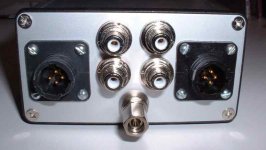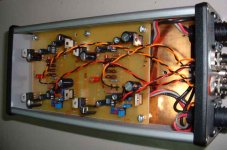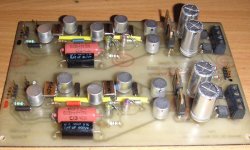rjm said:I'm working on the LM317 version. It will have only two regulators per channel, not four. I have had the single-sided layout in my head since way back - theres practically only one way to do it single-sided without jumpers - but putting it on half a Eurocard in a logical way is proving hard, unless I drop back to smaller resistors and offer less flexibility on the RIAA capacitor selection. Alternatively I could go with a double-sided layout, the problem is there are so many layout options to choose from I cant decide where to start.
To be single or double sided, that is the question....
-rjm
My vote is for double sided with a ground plane.
Just completed my PhonoCLone and the sound is just WOW 😱
I was using a NAD PP2 before and the upgrade is just breathtaking. I can hear layers in the music, the different mike technics used. The sound is organic and fluid.
The noise is almost no existent. It is below the LP surface noise.
The supply noise is there because the supply caps are so small, but you hear it only at deafening sound level with no music. In normal use, it is nothing. If the small caps contribute to this speedy and great sound, I take them anytime 😀
It is the best phono preamp that I had built so far. I'm still working of my ONO preamp 😉 but this one is much easier to build and much cheaper too.
Very recommended.
Here a view of the preamp's rear. Both supply connectors on the side. The input and output RCA in the middle.
I was using a NAD PP2 before and the upgrade is just breathtaking. I can hear layers in the music, the different mike technics used. The sound is organic and fluid.
The noise is almost no existent. It is below the LP surface noise.
The supply noise is there because the supply caps are so small, but you hear it only at deafening sound level with no music. In normal use, it is nothing. If the small caps contribute to this speedy and great sound, I take them anytime 😀
It is the best phono preamp that I had built so far. I'm still working of my ONO preamp 😉 but this one is much easier to build and much cheaper too.
Very recommended.
Here a view of the preamp's rear. Both supply connectors on the side. The input and output RCA in the middle.
Attachments
Thats really nice work, Algar_emi🙂 How did you make the extern psu? Is it built to RJM's spec's?
Steen🙂
Steen🙂
noise levels
I have tested the phoneclone now with two cartridges:
DENON 160 (Yes I am aware, high output)but this is my test set-up) and
ZYX RS10-02 (low output) in my real listening set-up.
I do use 4 opa27's and onboard regulation of 15V (78/7915)
The DC comes either from batteries or from a preregulated 18V DC (LM 317/337).
Denon 160
Apart from some hum due to layout, really awsome
At the moment I do prefer the preregulated use, some more steady low. Less spectacular, more musical.
ZYX RS10-02
Relatively high noise level, both with batteries as well as with Prereg DC. Better system thus anyhow better sound.
As the Rs of this cartidge is (only) 4 ohm I brought down R2 to 1k. This did help somewhat with the noise level. The R1 is at 150R because input impedance is quoted >100R.
With no cartridge connected no-noise (ink black), as soon as this cartridge is connected I have noise, far above vinyl surface noise?
I did hear some what longer time ago a ZYX20 on an original phonecube. No relevant noise. The only difference between the 10 and 20 is the shape of the stylus.
In what direction should I search to get rid of the noise?
Thanks for all inputs.
E&E
I have tested the phoneclone now with two cartridges:
DENON 160 (Yes I am aware, high output)but this is my test set-up) and
ZYX RS10-02 (low output) in my real listening set-up.
I do use 4 opa27's and onboard regulation of 15V (78/7915)
The DC comes either from batteries or from a preregulated 18V DC (LM 317/337).
Denon 160
Apart from some hum due to layout, really awsome
At the moment I do prefer the preregulated use, some more steady low. Less spectacular, more musical.
ZYX RS10-02
Relatively high noise level, both with batteries as well as with Prereg DC. Better system thus anyhow better sound.
As the Rs of this cartidge is (only) 4 ohm I brought down R2 to 1k. This did help somewhat with the noise level. The R1 is at 150R because input impedance is quoted >100R.
With no cartridge connected no-noise (ink black), as soon as this cartridge is connected I have noise, far above vinyl surface noise?
I did hear some what longer time ago a ZYX20 on an original phonecube. No relevant noise. The only difference between the 10 and 20 is the shape of the stylus.
In what direction should I search to get rid of the noise?
Thanks for all inputs.
E&E
don't know how to edit
I don't know how to edit my previous post?
But DENON 160 should read DENON 110.
I don't know where that confusion came from. I do own a 110 and a 103
E&E
I don't know how to edit my previous post?
But DENON 160 should read DENON 110.
I don't know where that confusion came from. I do own a 110 and a 103
E&E
E&E
- you can only edit text for 1h or so after you post it.
- with the ZYX RS10-02, R1 should be a couple of ohms or zero. Set R2 to about 400 ohms.
- the rest of the noise may be due to layout issues. See back to the discussion earlier in this thread.
- R1 should always be set to the cartridge impedance or less, never the rated load resistance. At 150 ohms, you've unnecessarily added a significant noise source into your circuit.
/R
- you can only edit text for 1h or so after you post it.
- with the ZYX RS10-02, R1 should be a couple of ohms or zero. Set R2 to about 400 ohms.
- the rest of the noise may be due to layout issues. See back to the discussion earlier in this thread.
- R1 should always be set to the cartridge impedance or less, never the rated load resistance. At 150 ohms, you've unnecessarily added a significant noise source into your circuit.
/R
I'm using a Denon 110 too. In my preamp I have a jumper to select the R1 resistor. I'm also using a 160R value at the moment, but I can also use a 47R. I'll try the 47R and I'll report of my finding.
Which of the designs would be best for an SP14 cartridge?
Also if it is the VSPS, is it the low or high impendance one?
Also if it is the VSPS, is it the low or high impendance one?
Great RJM,
I will try to implement your suggestions over Christmas and report my findings ASAP.
Happy Hollidays
E&E
I will try to implement your suggestions over Christmas and report my findings ASAP.
Happy Hollidays
E&E
The noise component from R1 should be less than the noise of the OP27 opamp itself for any value less than 1k.
I would, however, appreciate it if someone were to try with R1/without (ie shorted) and see if they could hear any difference.
I would, however, appreciate it if someone were to try with R1/without (ie shorted) and see if they could hear any difference.
Need some help troubleshooting
Hey All,
I designed my powersupply and wired it exactly as layed out in the phonoclone hint page. Each channel board works perfectly when they are wired by themselves to the powersupply and fed a signal from the source. I also tested sending the signal from both channels of the source. The problem happens when both boards are wired to the powersupply and fed both l/r signals. Only one side will play and the other is completely distorted and/or not play at all. If I hold the point where both COM lines to the boards connect in the case, the distortion on the bad channel clears up a bit and starts playing.
It's definitely a grounding problem but for the love of all things good I can't figure out what's causing it. Could someone help me troubleshoot this?
thanks!
-erik
Hey All,
I designed my powersupply and wired it exactly as layed out in the phonoclone hint page. Each channel board works perfectly when they are wired by themselves to the powersupply and fed a signal from the source. I also tested sending the signal from both channels of the source. The problem happens when both boards are wired to the powersupply and fed both l/r signals. Only one side will play and the other is completely distorted and/or not play at all. If I hold the point where both COM lines to the boards connect in the case, the distortion on the bad channel clears up a bit and starts playing.
It's definitely a grounding problem but for the love of all things good I can't figure out what's causing it. Could someone help me troubleshoot this?
thanks!
-erik
I will test with short and somewhere between 1R and R for R1.
Probably report in the course of the coming week
regards
E&E
Probably report in the course of the coming week
regards
E&E
Having deja vu... this is the 2nd one I have built. The 1st one I gave to the friend and I now remember having the same problem. I hardwired a nice set of shielded cables from the TT and one of them had a short in the rca enclosure. That was the problem.
neeldz,
Could the return input (IN-) path of one or both channels be connected to the turntable ground (COM, essentially) somewhere upstream of phonoclone this time, too, either in a improperly connected cable or in the tonearm somewhere?
/R
Could the return input (IN-) path of one or both channels be connected to the turntable ground (COM, essentially) somewhere upstream of phonoclone this time, too, either in a improperly connected cable or in the tonearm somewhere?
/R
In the meantime I converted the VSPS ultra in the ethernet hub box to a VSPS.
I compared this double mono VSPS to the stereo battery operated VSPS I used at the ETF 05.
The main differences, between the two (both based on OPA134 and Audyn Cap outputcaps, bypassed by sowjet MKP's):
New: double mono, 2 x 50VA trannies, LM7808/7908, Oscon. RIAA caps NOS polystyrene.
ETF 05: stereo, battery operated at 15-0-15V, Panasonic FC and Oscon, RIAA caps silver mica.
Conclusion:
- The double mono amp has remarkable better soundstage
- The double mono is less noisy (infact dead silence) than the battery operated. The difference must be the lower voltage and some grounding issues.
- Soundwise, I prefer the polystyrene caps over the micas.
This was now the second VSPS, I presented to a friend and was not allowed to bring it back home 😎
As I still use my first phonoclone, based on a double opamp OPA2227, I want to consolidate my system an will build a double mono phonoclone, based on AD797 and OPA228P.
Here the assembled board. The black MKP 4 coupling caps 0.47uF will be replaced by 1uF Audyn Cap after christmas holidays.
Franz
I compared this double mono VSPS to the stereo battery operated VSPS I used at the ETF 05.
The main differences, between the two (both based on OPA134 and Audyn Cap outputcaps, bypassed by sowjet MKP's):
New: double mono, 2 x 50VA trannies, LM7808/7908, Oscon. RIAA caps NOS polystyrene.
ETF 05: stereo, battery operated at 15-0-15V, Panasonic FC and Oscon, RIAA caps silver mica.
Conclusion:
- The double mono amp has remarkable better soundstage
- The double mono is less noisy (infact dead silence) than the battery operated. The difference must be the lower voltage and some grounding issues.
- Soundwise, I prefer the polystyrene caps over the micas.
This was now the second VSPS, I presented to a friend and was not allowed to bring it back home 😎
As I still use my first phonoclone, based on a double opamp OPA2227, I want to consolidate my system an will build a double mono phonoclone, based on AD797 and OPA228P.
Here the assembled board. The black MKP 4 coupling caps 0.47uF will be replaced by 1uF Audyn Cap after christmas holidays.
Franz
Attachments
I tried for R1 two values 160R and 47R using a Denon DL-110 cartridge. The noise level and sound are the same with both R1 values. So I guest, I'll keep the lowest one for R1, 47R.
- Home
- Source & Line
- Analogue Source
- The Phonoclone and VSPS PCB Help Desk


